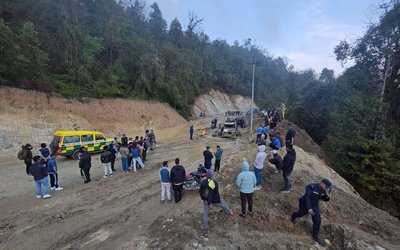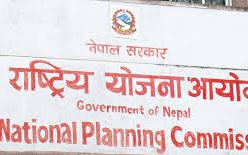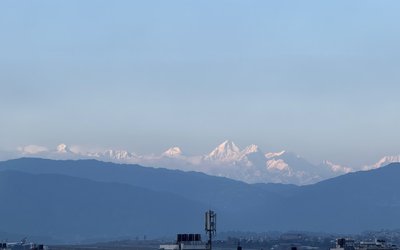
Despite lockdown at Pashupati Nath Temple and other religious places duet to a threat of COVID-19, devotees across Nepal have observed Bala Chaturdashi today. The day is also called satbij chharne din. A day before Bala Chaturdashi thousands of devotees used to campaign outside Pashupati Temple and other Shiva Temple .
The day is also called satbij chharne din. Camping under the open sky or tents arranged by the Pashupati Area Development Trust, the bereaved ones observe penance, light oil lamps and keep themselves awake throughout the night, praying for the departed souls to rest in heaven a day before Bala Chaturdashi.
Bala Chaturdashi or Satbij Charni Ausi is observed at Sleshmantak forest. Sleshmantak forest is situated to the other side across the Bagmati river by the Pashupatinath Temple.
Bala Chaaturdshi falls on Marga Krishna Chaturdasi. It is during late November or early December in English calendar.
Bala Chaturdashi or Satbij Charni Ausi is observed at Sleshmantak forest. Sleshmantak forest is situated to the other side across the Bagmati river by the Pashupatinath Temple.
Bala Chaaturdshi falls on Marga Krishna Chaturdasi. It is during late November or early December in English calender.
When is Bala Chaturdashi
This year Bala chaturdashi is on Mangir 28, 2077 BS or December 13, 2020 AD.
People from various places of Nepal and Hindus from other South Asian countries gather at Pashupatinath temple. Pashupati nath is the most sacred temple of lord Shiva situated at the bank of holy Bagmati River in Kathmandu.
Bala Chaturdasi
बाला चतुर्दशी
सुवर्ण रक्तिका तुल्यं ब्रीहिमेकं परिक्षिपेत .
मिर्गस्थालीं परिभ्रम्य पुनर्जन्म न बिध्यते
पूज्यत्पशूपं देवं गुहेशीं परमेश्वोरीं
वाशुकीं नागरजेन्द्रं तद्हीने पूजनं चरेत
How do we observe Bala Chataurdashi
We light traditional oil lamps (diyo) and recite mantras. We keep ourselves awake all night to ensure that the lamp keeps burning. We chant mantras, sing Bhajans and dance through night paying honor to Lord Shiva. The next day at daybreak we go to the holy Bagmati River for ritual bathing. Bagmati is considered to be the holiest river for all Nepali. Taking a dip three times into Bagmati River is considered a path to purification.
Diyo
After bathing in the Baghmati River pilgrims visits and worships almost all of the temples and idols in and around Pashupatinath as much they can. The devotees pass dropping the satbij, the mixture of seven sacred seeds in these temples and the 108 Shiva Linga present in the vicinity of Pashupatinath Temple. All walk through the same path followed for many years. It passes through Kailash forest and return back to the Pashupatinath temple.
The end part of Satbij dropping ceremony is done for fun after long walk and rituals. Lord Ganesh’s idol present near the Bishwaroop temple is believed to be deaf; people shake him and scream and shout in the ear to wake him up. This adds a fun flavor to the whole ceremony.
Why is Bala Chaturdashi Observed
Seeds are dropped in remembrance of dead beloved ones. It is believed by performing Bala Chaturdashi rituals we can secure a better place in heaven for the dead relatives. It is also believed that this helps settle the restless souls of departed ones who were not properly burnt. This is true that when thousands of people pray for the same consideration, that will be fulfilled.
Slesmantak forest, where the satbij is dropped is mentioned in Shiva Puran Mirgasthali as the place where lord Shiva dwelled as Deer. This place is hence considered a very sacred place and hence a drop of seed in this place is equal to a Ratti of gold (which is about 0.121 grams).
Story Behind Bala Chaturdashi
Bala Nanda, a trader, came to Arya Ghat (where people are cremated through burning), to attend funeral of one of his relatives. Bala Nanda sitting nearby and eating the ceremonial food, a small portion of the dead body popped out from the fire into his plate. He unknowingly swallowed flesh of dead body that fell into his plate. Soon he swallowed the flesh he transformed into a horrible demon having silver head. He became cannibal (man eating human meat). Bala Nanda suddenly grabbed out dead body from the fire and started eating it. People were terrified and ran away.
Then onwards he is called Balsur. Asur meaning Demon. (Bala+Asur=Balasur). Arya Ghat then became the favorite place for Balasur. People were scared to go to Arya Ghat to cremate dead relatives. People pleaded then king to solve the problem. King assigned Brisha Singh, very good friend of Balasur to kill him. Brisha manage to kill Balasur by betrayal.
Brisha felt guilty to deceive Bala. He went to meditation in the Sleshmantak Ban (forest) and enchanted Om and prayed to Lord Shiva for the rescue of his friend Balasur. Lord Shiva was pleased by his sincere affection for his friend. Lord Shiva helped in salvation of Balasur. Lord Shiva also told Brisha to scatter sat bij, or seven varieties of grain, on the holy grounds of the Shlesmantak forest to cleanse the sin of Balasur and to erase his own guilt for killing a friend. From the day, the tradition of Dropping Seven Grains (Sat biu) started.



- Nepal Electricity Authority cancels contract worth over Rs 1 billion, now electricity wires going to customers' homes are bare
- Apr 21, 2025
- Four people died in Taplejung after their vehicle caught fire after getting entangled in a live wire
- Apr 21, 2025
- RPP General Secretary Rana released on bail
- Apr 21, 2025
- Nepal requires Rs 21.165 trillion to implement SDGs goals
- Apr 21, 2025
- Putin's unilateral 'Easter ceasefire' ends, Ukraine suggests partial truce
- Apr 21, 2025















